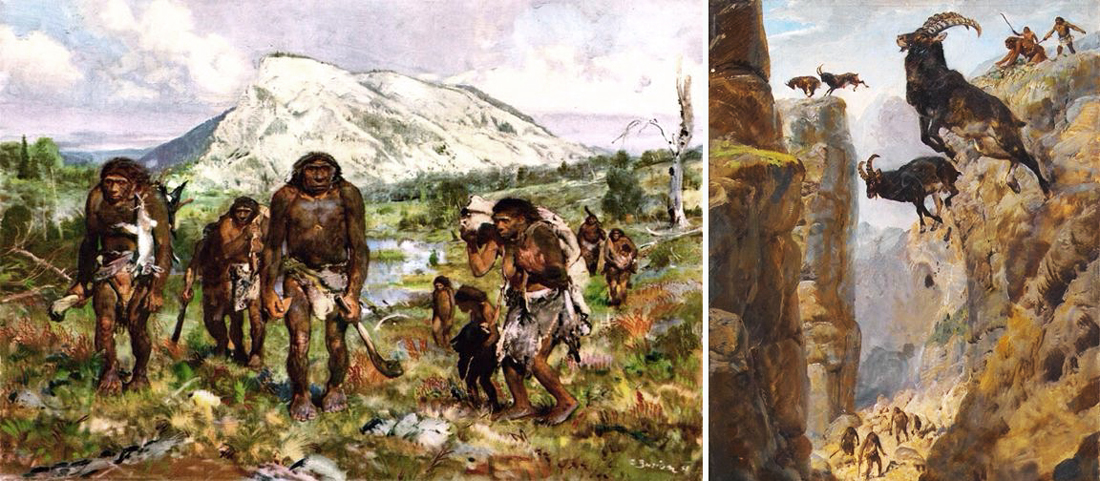


An article by Richard Gray for mailonline - Were Neanderthals master tacticians? Early human relatives used meticulously planned strategies to hunt Ice Age beasts - reports on the forensic analysis of hunting sites revealing Neanderthal hunting tactics. By using the landscape to funnel prey towards bottlenecks, they were then able to ambush and kill. The sites reveal that the Neanderthal hunters then butchered selectively.
#Neanderthal efficient tacticians and selective butchershttps://t.co/Tcu1gMpPMA #archaeology #prehistory pic.twitter.com/9qTO4zuN4o
— Bradshaw Foundation (@BradshawFND) March 30, 2016
Image: Natural History Museum, London
No longer thought of as cumbersome hunters, new forensic analysis of the Neanderthal hunting grounds has revealed them as efficient tacticians and selective butchers. This was thought to be traits of only our own species, Homo sapiens.

Image: Zdenek Burian.
Zdenek Burian(1905 - 1981) was a Czech painter and book illustrator whose work played a central role in the development of palaeontological reconstruction. He is regarded as one of the most influential palaeoartists of the modern era.
Built for distance running, it is thought bands of Homo sapiens isolated and chased down individual prey until they tired enough to be killed. Neanderthals were comparatively more heavily built and thought to have been far slower. However, it appears that Neanderthal herded their prey, which were often large herbivores like reindeer, horses, rhinos and bison, into areas where they could easily ambush them.
Professor Mark White, a Palaeolithic archaeologist at Durham University states that Neanderthals appeared to repeatedly use the same 'kill sites'. The remains of animals found at these sites suggests the hunters killed herd animals almost indiscriminately and then selectively butchered the fattest animals.
Neanderthals were very adept at spotting places within their home range where animals could be disadvantaged - cul-de-sacs, bottlenecks, charts depressions, precipices, blind corners. They used the animals flight behaviour to manipulate them into these places, where they killed as many animals as they could get or wanted. Because most prey species were larger and faster (and perhaps more dangerous) than Neanderthals, ambushing prey was a way of turning things to their advantage with the element of surprise and forced panic eliminating the speed and size advantage the animals naturally had.
Professor White and his colleagues outline their findings in the journal Quaternary Science Reviews:
'Shoot first, ask questions later: Interpretative narratives of Neanderthal hunting'
Volume 140, 15 May 2016, Pages 1-20
For the study, the scientists examined several sites where large collections of ice age animal bones have been discovered and are thought to have been victims of Neanderthal hunts. By examining the behaviour of modern animals when pursued by predators or when being herded, the researchers were able to reconstruct what may have happened in each landscape.
The Mauran site in France has an assemblage of 4,150 bison bones from 137 individuals; Neanderthals repeatedly used the natural topography - a cul-de-sac with open vegetation and marshy ground - to disadvantage bison.
Horse remains found in Zwolen, Poland, also suggest Neanderthals targeted harem groups by driving the animals down a grassy floodplain into natural bottlenecks produced by the river and cliffs.
Reindeer remains found at Salzgitter, Lebenstedt, Germany, were also killed in a similar way by intercepting the herd as they made their way towards their rutting ground.
Every dead animal was skinned for the fur, but only the fattest individuals with the best cuts of meat were butchered while the rest of the carcasses were left to rot.
Note: This was a common prehistoric hunting technique used in North America, with numerous sites. One example has been well documented - the Coso Range in Eastern California.
Bighorn hunting, resource depression, and rock art in the Coso Range, eastern California: a computer simulation model
By Alan P. Garfinkel et al
Journal of Archaeological Science
Volume 37, Issue 1, January 2010, Pages 42-51
Read more about Homo neanderthalensis in the ORIGINS section:
http://www.bradshawfoundation.com/origins/homo_neanderthalensis.php
Read more about the Coso Range:
by Bradshaw Foundation
Tuesday 21 March 2023
by Bradshaw Foundation
Tuesday 07 February 2023
by Bradshaw Foundation
Thursday 19 May 2022
by Bradshaw Foundation
Tuesday 19 October 2021
by Bradshaw Foundation
Friday 25 June 2021
by Bradshaw Foundation
Monday 09 November 2020
by Bradshaw Foundation
Tuesday 03 November 2020
by Bradshaw Foundation
Wednesday 28 October 2020
by Bradshaw Foundation
Tuesday 23 June 2020
by Bradshaw Foundation
Thursday 04 June 2020
by Bradshaw Foundation
Thursday 14 May 2020
by Bradshaw Foundation
Tuesday 12 May 2020
by Bradshaw Foundation
Wednesday 19 February 2020
by Bradshaw Foundation
Tuesday 21 January 2020
by Bradshaw Foundation
Monday 20 January 2020
by Bradshaw Foundation
Thursday 28 November 2019
by Bradshaw Foundation
Tuesday 21 March 2023
by Bradshaw Foundation
Tuesday 07 February 2023
by Bradshaw Foundation
Thursday 19 May 2022
by Bradshaw Foundation
Tuesday 19 October 2021
by Bradshaw Foundation
Friday 25 June 2021
by Bradshaw Foundation
Monday 09 November 2020
by Bradshaw Foundation
Tuesday 03 November 2020
by Bradshaw Foundation
Wednesday 28 October 2020
by Bradshaw Foundation
Tuesday 23 June 2020
by Bradshaw Foundation
Thursday 04 June 2020
by Bradshaw Foundation
Thursday 14 May 2020
by Bradshaw Foundation
Tuesday 12 May 2020
by Bradshaw Foundation
Wednesday 19 February 2020
by Bradshaw Foundation
Tuesday 21 January 2020
by Bradshaw Foundation
Monday 20 January 2020
by Bradshaw Foundation
Thursday 28 November 2019
Friend of the Foundation











